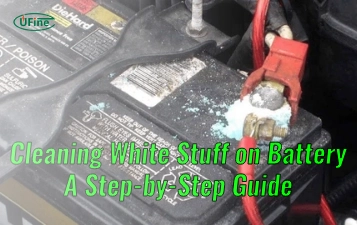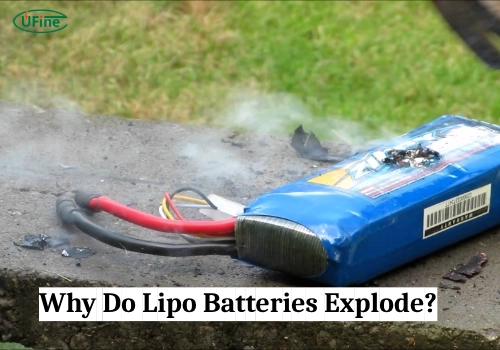What Causes LiPo Battery Explosions? LiPo (Lithium Polymer) battery explosions occur due to several key factors, including overcharging, physical damage, and improper storage. These can cause thermal runaway, which leads to overheating, swelling, and potentially dangerous explosions. To prevent this:
- Use compatible chargers.
- Store batteries at safe voltage levels.
- Regularly inspect for signs of damage.
- Follow manufacturer guidelines for charging and discharging.
Why LiPo Batteries Explode?
LiPo batteries are prone to explosion due to overcharging, physical trauma, manufacturing defects, improper storage, and ageing. The most common cause is overcharging, which leads to thermal runaway. Always ensure batteries are used according to safety guidelines.
Part 1. Why do LiPo batteries explode?
LiPo batteries can explode due to various factors compromising their structural integrity and chemical stability. Understanding these causes is crucial for preventing such hazardous incidents:
Overcharging: When LiPo batteries are charged beyond their capacity or at excessive rates, they experience a phenomenon called “thermal runaway.” This rapid increase in temperature can cause the battery to swell, leak electrolytes, and ultimately explode.
Physical Damage: Any physical trauma, such as punctures, dents, or exposure to high temperatures, can compromise the battery’s internal structure. This damage can create short circuits within the cells, triggering a chain reaction that results in an explosion.
Manufacturing Defects: Inadequate quality control during manufacturing might introduce defects in the battery structure or the materials used. These defects can lead to instability, increasing the likelihood of explosions under certain conditions.
Improper Storage: Storing LiPo batteries in environments with extreme temperatures or high humidity levels can degrade the internal components, potentially leading to malfunction and explosions.
Incorrect Usage: LiPo batteries in applications that exceed their recommended voltage or current limits can stress the cells, causing internal damage and eventual explosions.
Age and Wear: As LiPo batteries age, their internal components degrade. Continual usage and charging cycles can weaken the battery’s structure, making it more susceptible to failure and explosion.
Charging with Unapproved Equipment: Chargers or equipment not designed for LiPo batteries can result in incorrect voltage, current, or charging rates, leading to instability and eventual explosion.
Part 2. LiPo charging
LiPo battery charging is critical and demands precise attention to prevent hazardous situations such as explosions or fires. Here’s a detailed breakdown of essential practices:
Use Compatible Chargers: Employ only chargers explicitly designed for LiPo batteries. These chargers regulate voltage and current, preventing overcharging and mitigating explosion risks.
Monitor Charging Cycles: Never leave LiPo batteries unattended during charging. Regularly check the battery and charger for any signs of malfunction or overheating. Investing in a balanced charger ensures equal charging among individual cells, enhancing safety.
Follow Manufacturer Guidelines: Adhere strictly to the manufacturer’s instructions regarding charging rates, voltage limits, and recommended charging practices. Deviating from these guidelines significantly increases the likelihood of accidents.
Avoid Overcharging: Disconnect the battery from the charger promptly once it is fully charged. Overcharging can lead to thermal runaway, causing the battery to heat up and potentially explode.
Regular Inspections: Periodically inspect the charging cables, connectors, and battery terminals for any signs of damage or wear. Replace any faulty components immediately to prevent potential hazards during charging.
Part 3. LiPo discharge
Here’s a comprehensive guide on safe discharge:
Avoid Over-Discharging: Never deplete a LiPo battery below its safe voltage threshold. Continuously discharging the battery beyond its recommended limit can cause irreparable damage to the cells, leading to instability during subsequent charging.
Utilize Discharge Devices: Use specialized LiPo battery discharge devices or dischargers designed to reduce the battery’s charge to a safe level. These devices prevent over-discharging and maintain the battery’s integrity.
Regular Monitoring: Use a compatible voltage checker or meter to periodically check the battery’s voltage. This allows users to gauge the battery’s charge level and take necessary precautions to avoid over-discharging.
Balanced Discharging: Ensure that batteries used in series or parallel configurations discharge evenly across all cells. A balanced discharger helps maintain uniform voltage levels among cells, enhancing safety during discharge cycles.
Avoid Rapid Discharge Rates: Extremely rapid discharge rates generate excessive heat within the battery, potentially leading to thermal runaway. Use batteries within their specified discharge rates to prevent overheating and explosions.
Part 4. LiPo battery store
Storing LiPo batteries demands careful attention to prevent potential hazards like explosions or degradation over time. Here’s a detailed guide on safe storage practices:
Temperature and Environment: Store LiPo batteries in a relaxed, dry environment away from direct sunlight and extreme temperatures. Ideally, the storage temperature should range between 50-70°F (10-21°C) to maintain battery health.
Lipo Safe Bag: Place LiPo batteries in specialized fireproof containers or bags designed explicitly for battery storage. These containers help contain potential fires or explosions, limiting their impact.
Storage Voltage Level: When storing LiPo batteries for an extended period, ensure they are at a recommended storage voltage. Most manufacturers suggest storing batteries at around 3.8–3.85 volts per cell to maintain stability without causing degradation.
Regular Inspections: Periodically inspect stored batteries for signs of physical damage, swelling, or leakage. Discard or recycle any batteries showing abnormalities to prevent potential hazards.
Isolation and Protection: Store LiPo batteries away from flammable materials or substances. Isolate them in a dedicated storage area or container to reduce the risk of fires spreading in case of a battery malfunction.
Avoiding Full Charges for Long-Term Storage: If you do not intend to use LiPo batteries for an extended period, it’s advisable to charge them only partially. Instead, store them at the recommended storage voltage to prolong battery life.
Part 5. LiPo battery disposal
Here’s a comprehensive guide to safe disposal practices:
Discharge Batteries: Before disposal, fully discharge the LiPo batteries to a safe voltage level. Use a discharge device or follow manufacturer recommendations to remove the batteries safely.
Place in Saltwater: Submerge discharged LiPo batteries in a saltwater container for at least two weeks. This process helps neutralize any remaining charge within the cells, reducing the risk of fire or explosion during disposal.
Battery Protection: Before disposal, cover the LiPo batteries in a non-conductive material like electrical tape to prevent potential punctures or damage. This reduces the likelihood of short circuits and accidents.
Recycling Facilities: Some recycling facilities accept LiPo batteries for proper disposal. Check with local recycling centres, electronic stores, or battery retailers if they have programs for recycling batteries.
Avoid Incineration: Never incinerate LiPo batteries. Burning them releases harmful chemicals into the air, which can cause explosions or fires, posing risks to health and the environment.
Artikel Terkait: How to Care for LiPo Batteries?
Part 6. FAQs
-
How do LiPo batteries explode?
LiPo batteries explode when they are overcharged, physically damaged, or exposed to extreme temperatures. These conditions can cause overheating, swelling, and leakage. -
What causes a LiPo battery to catch fire?
A LiPo battery catches fire mainly due to improper charging, physical damage, or using damaged batteries. When exposed to high temperatures or charged incorrectly, the battery can enter thermal runaway and catch fire. -
How can you prevent lithium batteries from exploding?
To prevent explosions, avoid physical damage, overcharging, and overheating. Use proper chargers, store batteries in cool, dry places, and avoid extreme conditions. -
How do you stop a LiPo battery from catching fire?
In case of a LiPo battery fire, disconnect it from power immediately, move it away from flammable materials, and use a Class D fire extinguisher or fire-resistant container to extinguish the flames. -
How do you store LiPo batteries at home?
Store LiPo batteries in fireproof containers or LiPo-safe bags, ideally in a cool, dry place away from direct sunlight or heat sources. Ensure they are at around 3.8V to 3.85V per cell storage charge levels to prevent degradation. -
Can LiPo batteries catch fire in storage?
Yes, LiPo batteries can catch fire in storage if damaged, overcharged, or stored in improper conditions. It’s essential to monitor their health and avoid keeping them at full charge for long periods.
Related Tags:
More Articles

White Stuff on Battery Terminals: A Step-by-Step Cleaning and Maintenance Guide
White stuff on battery terminals is corrosion. Learn how to clean it safely, prevent damage, and keep your battery running strong with simple steps.
Understanding How Glass Mat Batteries Work: Technology, Benefits, and Limitations
Glass mat batteries power cars, RVs, and solar systems. Learn how they work, their benefits, and what to consider before choosing one.
A Buyer’s Guide for AA Size Lithium Battery
Discover the power of AA size lithium batteries—types, voltage, capacity, and more! Learn how to choose the best one for your needs. Read now!
Li-Ion Battery Prices – Where to Buy Cheap & Safe
Discover li-ion cell prices, key market factors, and how to find affordable custom batteries from top suppliers like Ufine Battery.
How Long Does a 2200mAh Battery Last?
Discover everything about 2200mAh batteries—types, charging time, lifespan, and whether it’s enough for your device.








